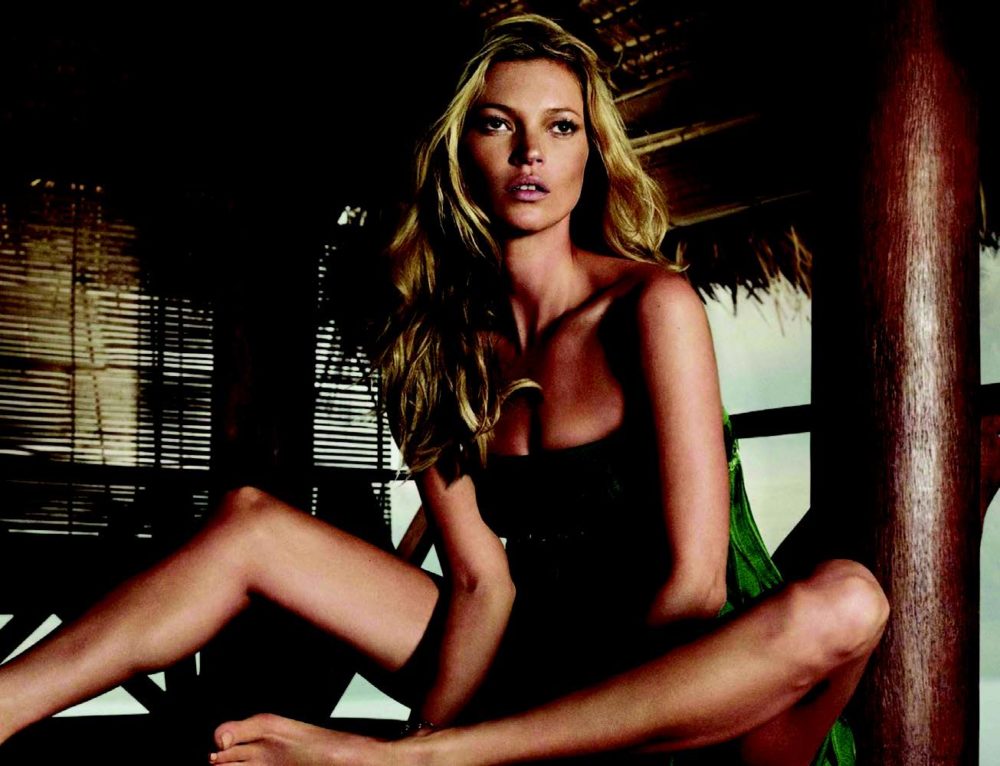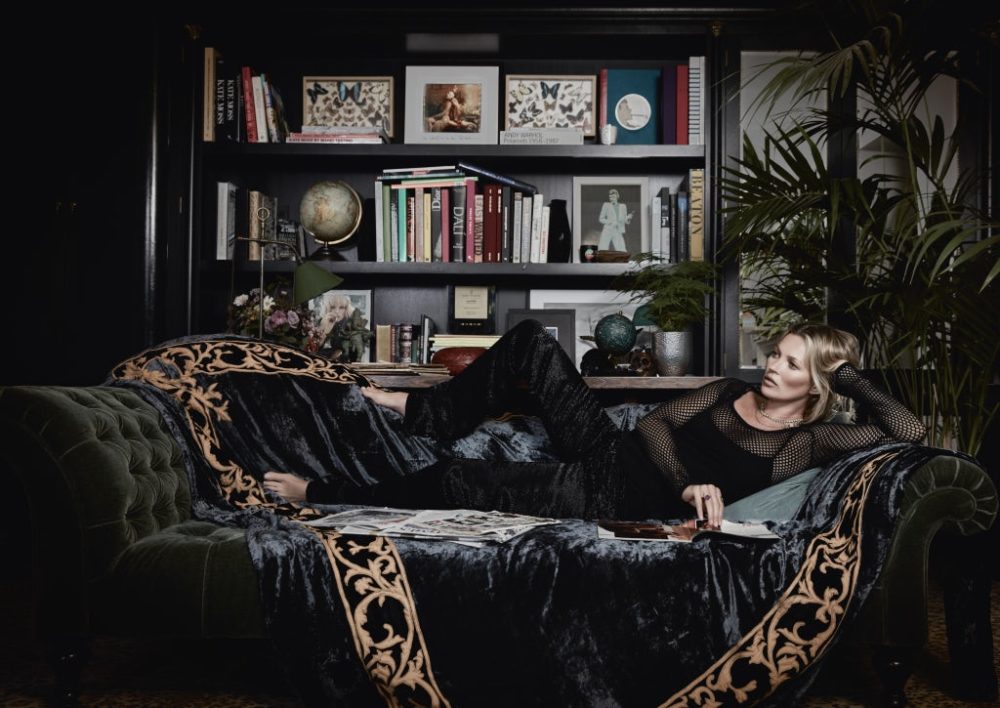Today, Moss is the only one of the 1990s-era supermodels who still has an active and lucrative career in modelling.

According to analysis conducted by Forbes, she earned $5 million between June 2015 and June 2016, ranking her 13th amongst the 20 highest earning models in the world. This may be less than in years past, when Forbes says she earned up to a13 million or more, but at 42, Moss is the oldest model on this yearʼs list and has the longest uninterrupted streak at the top of the modelling game, making her one of the richest women in Britain with a net worth estimated by The Sunday Times to be more than $75 million. But she isnʼt letting up anytime soon.
So, if youʼre Kate Moss, already one of the worldʼs most famous fashion icons, what do you do next?
Earlier this year, Moss took the industry by surprise when she left Storm Models after 27 years. Instead of going to a rival agency, however, Moss brought her agenting in-house and quietly began acting on a plan that could transform her from supermodel to budding businesswoman.
This month, Moss is launching her own talent management agency: Kate Moss Agency. “It’s a dream! It’s so weird,” she laughs, at the prospect of spotting and backing new faces. “You know that film ‘Gia’? Faye Dunaway plays the agent. I could so do that! But I want to focus more on managing peopleʼs careers than just [running] a modelling agency. I don’t really want pretty people, I want people that want to sing and dance and act — I want to create stars,” she says.
At first, the agency will work with a handful of talents and represent them as models. To make her vision a reality, Moss has quietly been building a small team to work alongside Lucy Baxter, her longtime booking agent, who also left Storm earlier this year.

The supermodel-turned-businesswoman is also expanding the Kate Moss lifestyle brand with a string of new collaborations and projects set to roll out later this year.
The move is a natural extension of her previous work for the likes of TopShop, LongChamp and Equipment, all of whom have banked on her brand power, working with her during her time at Storm to launch new products bearing her name.
“I’ve definitely been there and done it all, and I know the things that you don’t have to do and maybe things that you should, which aren’t the normal way of doing things. It’s just how I know the business. I chose the jobs I wanted to do and it seems to have worked for me. It’s about being selective and doing things that are true to yourself…” she trails off. “I want to start small. I donʼt want to be like, having a whole board of models.”
“It’s more of a management company with creative people, but we’ll be working with them as models,” elaborates Johnson-Hill. “So there will be people such as artists or designers or curators or dancers — all people that have creative interests as part of their personalities.”
Moss continues to model today, demonstrating unusual staying power in an industry known for casting older models aside in favour of newer, younger faces. She still regularly does covers for Italian, French and especially British Vogue and, this year, has fronted campaigns for Charlotte Tilbury, Decorté, Naked Cashmere and Alberta Ferretti, as well as longtime clients David Yurman, Equipment, Rimmel London and Calvin Klein.
“That’s the thing, women do grow up as well,” says Moss. “Some of them have grown up with me, the women that buy clothes, that have been my age and followed me since I’d done Obsession. We were 18 then and I’m 42 now, and they’re just buying the clothes I’m modelling now instead of buying CK One or whatever.”
But in the age of so-called “Instagirls” — including Kendall Jenner, Karlie Klossand Gigi Hadid — the agency will quickly need to develop its social media expertise. “They’ve definitely got another side with it, like the Instagram side, and they know their business I think, and are really aware,” acknowledges Moss.
Moss herself has not had an official social media presence until now, but the agencyʼs new Instagram account (@KateMossAgency) will focus on Moss as well as her new protégées, eventually consolidating more than one million followers from hundreds of fan accounts.
The Kate Moss story is the stuff of fashion legend. She was discovered in 1988 by Storm’s Sarah Doukas at the age of 14 on a flight back to London from JFK airport. Just under 5 foot 7 inches, Moss was on the shorter side to be a runway model, especially when compared to the glamazons of the day. But according to Doukas, Moss had incredible bone structure and something special — call it charisma — that made her stand out.
So different was her look that, at the start, the only paid work she could score was for lowly catalogues. “I didn’t want to do catalogue work, I wanted to do The Face. I didn’t care if the catalogue was going to pay me $200 a day, I’d rather work for The Face for free than do that shit because it was just horrible, boring clothes that old ladies would wear. Even though I was 15, they’d dress me like a lady. It was really weird. The Face felt more like my generation — what we would wear.”

Things began to pick up in 1989, when she auditioned for John Galliano and walked in what was to be his last fashion show in London. The next year, Moss appeared on the cover of The Face twice. First for the May issue, shot by Mark Lebon, and then in July, shot by Corinne Day. It was the latter shoot — featuring her crooked smile, freckled face and a quirky feather headdress — that put Moss onto the radar of fashion insiders. The raw, unvarnished, black- and-white images proposed an altogether new fashion aesthetic, far from the glossy artifice that dominated mainstream fashion magazines at the time.
That same year, John Galliano called again on Moss, this time to appear in his first ever Paris show, her first time walking with the reigning supermodels of the day: Christy Turlington, Linda Evangelista and Naomi Campbell. Moss has fond memories of those early Galliano shows.
“Before a show, I’d ask, ‘Who am I, who am I?’” she recalls. “He’d give me a persona and say, ‘You are a girl from Croydon who has never had sex and is gagging for it and loads of sailors have just come into town and you’ve had a shot of tequila,’ and he would be like, ‘and gooooo!’ and push you out. That was so exciting. It was brilliant!”
But things really began to take off for Moss commercially when she went to America in 1991 with her new boyfriend, Mario Sorrenti, the handsome and well-connected photographer whose family lived in New York. Moss and Sorrenti had developed an almost obsessive creative partnership.
“We would stay up all night and he would spend all of his money on books and he would be in the dark room and I would be playing music,” remembers Moss. By then, the Corinne Day story from The Face was on the radar of Harper’s Bazaar editor-in-chief Liz Tilberis and creative director Fabien Baron.
Soon after they met Moss, she was featured in a nine-page editorial feature shot by Patrick Demarchelier for the magazine’s relaunch in September 1992. Demarchelier and Baron also happened to be working with Calvin Klein, who was in search of a new face to revitalise his fashion empire.
Reached by phone at his home in the Hamptons, Klein vividly recalls his first interactions with Moss. “I had been to a number of shows in Paris, and I noticed that all the models that I had thought were special in my show did every show there, so they were less special to me,” he says. “So I was looking for someone young, what we used to call in those days ‘downtown New York’ — someone with an edge. I discussed this with Patrick Demarchelier and he called me and said, ‘You know, someone just came in, this young woman and I think this might be what you’re looking for.ʼ He sent Kate over to my studio and I could tell that she was exactly what I was looking for,” recalls Klein.
“I was coming out with a collection called CK and she would be the face of that, as well as the fragrance and jeans. She could be anything I wanted her to be.”
Over the next few years, Moss rose from relative anonymity to being the global face of Calvin Klein, signing an exclusive five-year deal reported to be worth millions of dollars, including campaigns for CK, shot by Patrick Demarchelier; for Calvin Klein Underwear (with Mark Wahlberg), shot by Herb Ritts; and most importantly, for Calvin Klein Obsession, shot by Mario Sorrenti.
“The head of the fragrance company called about Obsession — a fragrance that was very big in the 1980s but whose sales had started to slip — and said, ‘You have to do something,’” recalls Klein. “I looked at these images that Mario took of Kate and I thought, Obsession. He was obsessed with her. I wanted to project that as the new image for the fragrance. So I sent those two to an island, so that Mario could photograph her and do a commercial.”

The campaigns caused sensation, driving the Calvin Klein business, while thrusting Moss into the centre of a debate about the sexualisation of young women and so-called “heroin chic.” Even Bill Clinton, in his second term as US President, weighed in on the debate, which continued to rage on a few years later.
“Fashion photos in the last few years have made heroin addiction seem glamorous and sexy and cool,” said Clinton. “You do not need to glamourise addiction to sell clothes. It is not creative. It’s destructive. It’s not beautiful. It is ugly. And this is not about art. It’s about life and death. And glorifying death is not good for any society.”
One thing you can be sure of Kate Moss will continue to make waves.







